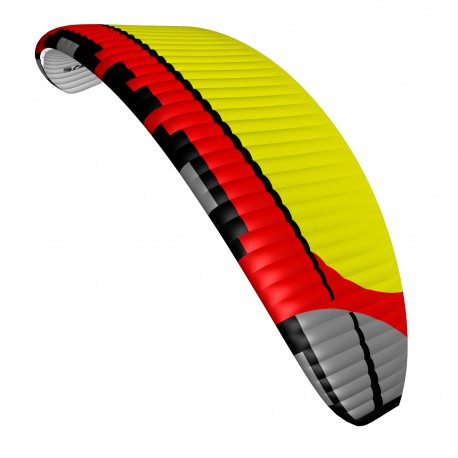Nav produktu
DUDEK - CABRIO
New
INFORMATION FROM MANUFACTURER WEBSITE
The Cabrio is our first design originally dedicated for paramotor tandems, especially heavier two-seater trikes (PPGG). Earlier we were simply adjusting already existing wings for heavier loads, resulting in "Cabrio" versions of the original designs. Now, seeing the ever growing number of paramotor tandem enthusiasts, we've created the real CABRIO - not an add-on for other designs, but a truly uncompromising paraglider, from the onset created to fulfill specific needs of the PL2 pilots.
The outline of the Cabrio is similar to our regular tandem paraglider, the Orca 4. Strengthened structure and rigging allow for optimal load distribution along the entire wingspan.
The FlexiEdge stiffeners, inner reinforcements and mini-ribs make sure the profile is exactly reproduced and stabilized. Mini-ribs on the trailing edge also allow it to be slender and reduce ballooning, thus significantly improving the airflow.
Based on the DRA (Dudek Reflex Airfoil) technology, the Cabrio aerodynamic profile is additionally equipped with shark-nose, thanks to which the pressure inside the canopy is higher and more stable over a wide speed range.
Variable profile geometry managed by trimmers allows you to adjust the profile to the current flight status, so that you can have a slow wing with much of lift during takeoff and landing, while enjoying good speed and stability in accelerated flight.
During launch the Cabrio fills up very well and rises with no tendency to fall behind or overtake the pilot. Thanks to the use of an additional delta on the "A" risers (a feature known from our earlier designs, including Nucleon Cabrio), pilot has the option of connecting assisting tapes or lines for the launch, so that only the main control handles remain in his hands, facilitatings full control over the wing.
The entire launch procedure is done over short distance, at slow speed and does not require much power.
The dual control system used in Cabrio is well known from our previous models. The wing is equipped with both main control and small TST handles, mainly used in accelerated flight (open trimmers). Such a system makes it easier for the pilot to control the wing and increases the effectiveness of turning without putting a lot of effort into it. TST lines pass through the TEA cleats, so it is possible to counteract the turning moment of the propeller (through earlier tying a knot at the appropriate height on the TST line, blocking it in the cleat slit).
By using the trim system, the pilot can accurately control both speed and direction of flight, through their partially asymmetrical positioning. On the landing approach a relatively small pull of the brakes is enough to considerably reduce speed and land smoothly.
TECHNICAL DATA
| Name - size | Cabrio 30 | Cabrio 34 | Cabrio 38 | Cabrio 42 |
| Approval - ULM identification | pending | pending | pending | pending |
| Number of cells | 53 | 53 | 53 | 53 |
| Wing area flat [m2] | 30.00 | 34.00 | 38.00 | 42.00 |
| Wing area projected [m2] | 25.51 | 28.91 | 32,44 | 35,71 |
| Wingspan flat [m] | 12.73 | 13,55 | 14,32 | 15,06 |
| Wingspan projected [m] | 10.12 | 10,78 | 11,39 | 11,98 |
| Aspect ratio flat | 5.4 | |||
| Aspect ratio projected | 4.0 | |||
| Sink rate [m/s] | min = 1.6; (+/- 0.2 m/s) | |||
| Speed [km/h] | min = 32, trim = 46; max = 56 (+/- 5 km/h) | |||
| Canopy weight [kg] | 6.45 | 7.07 | 7.57 | 8.17 |
| Take-off weight [kg] | 110-300 | 130-350 | 160-400 | 210-400 |
| Lines | Edelrid A-8000U: 050 / 7343: 90; 140; 190; 280; 340 Liros: PPSL 350 | |||
| Cloth | Porcher Sport 38 g/m2 Dominico Tex 34 g/m2 Porcher Hard Finish 40 g/m2 SR-Scrim, SR Laminate 180 g/m2 | |||
*speed measured at the middle weight range (pilot + passenger + 20 kg)














